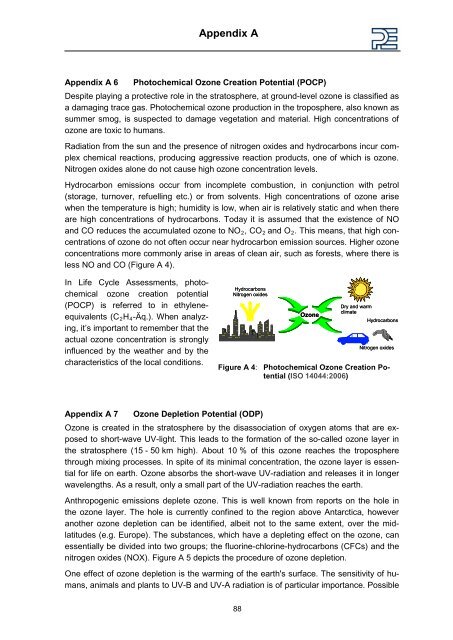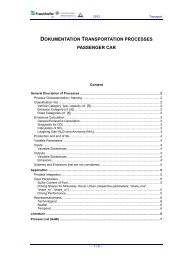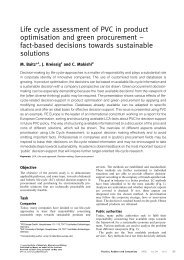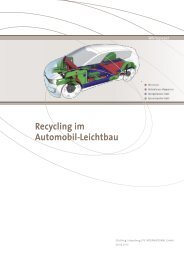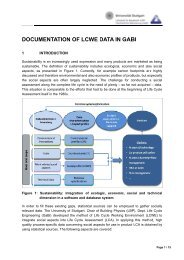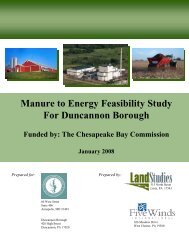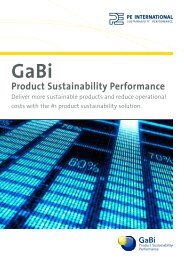Paper_Clip_Tutorial Part1.pdf - GaBi Software
Paper_Clip_Tutorial Part1.pdf - GaBi Software
Paper_Clip_Tutorial Part1.pdf - GaBi Software
You also want an ePaper? Increase the reach of your titles
YUMPU automatically turns print PDFs into web optimized ePapers that Google loves.
Appendix A<br />
Appendix A 6 Photochemical Ozone Creation Potential (POCP)<br />
Despite playing a protective role in the stratosphere, at ground-level ozone is classified as<br />
a damaging trace gas. Photochemical ozone production in the troposphere, also known as<br />
summer smog, is suspected to damage vegetation and material. High concentrations of<br />
ozone are toxic to humans.<br />
Radiation from the sun and the presence of nitrogen oxides and hydrocarbons incur complex<br />
chemical reactions, producing aggressive reaction products, one of which is ozone.<br />
Nitrogen oxides alone do not cause high ozone concentration levels.<br />
Hydrocarbon emissions occur from incomplete combustion, in conjunction with petrol<br />
(storage, turnover, refuelling etc.) or from solvents. High concentrations of ozone arise<br />
when the temperature is high; humidity is low, when air is relatively static and when there<br />
are high concentrations of hydrocarbons. Today it is assumed that the existence of NO<br />
and CO reduces the accumulated ozone to NO2, CO2 and O2.<br />
This means, that high concentrations<br />
of ozone do not often occur near hydrocarbon emission sources. Higher ozone<br />
concentrations more commonly arise in areas of clean air, such as forests, where there is<br />
less NO and CO ( Figure A 4).<br />
In Life Cycle Assessments, photochemical<br />
ozone creation potential<br />
(POCP) is referred to in ethyleneequivalents<br />
(C2H4 -Äq.). When analyzing,<br />
it’s important to remember that the<br />
actual ozone concentration is strongly<br />
influenced by the weather and by the<br />
characteristics of the local conditions.<br />
Hydrocarbons<br />
Nitrogen oxides<br />
Figure A 4: Photochemical Ozone Creation Potential<br />
(ISO 14044:2006)<br />
Appendix A 7 Ozone Depletion Potential (ODP)<br />
Ozone is created in the stratosphere by the disassociation of oxygen atoms that are exposed<br />
to short-wave UV-light. This leads to the formation of the so-called ozone layer in<br />
the stratosphere (15 - 50 km high). About 10 % of this ozone reaches the troposphere<br />
through mixing processes. In spite of its minimal concentration, the ozone layer is essential<br />
for life on earth. Ozone absorbs the short-wave UV-radiation and releases it in longer<br />
wavelengths. As a result, only a small part of the UV-radiation reaches the earth.<br />
Anthropogenic emissions deplete ozone. This is well known from reports on the hole in<br />
the ozone layer. The hole is currently confined to the region above Antarctica, however<br />
another ozone depletion can be identified, albeit not to the same extent, over the midlatitudes<br />
(e.g. Europe). The substances, which have a depleting effect on the ozone, can<br />
essentially be divided into two groups; the fluorine-chlorine-hydrocarbons (CFCs) and the<br />
nitrogen oxides (NOX). Figure A 5 depicts the procedure of ozone depletion.<br />
One effect of ozone depletion is the warming of the earth's surface. The sensitivity of humans,<br />
animals and plants to UV-B and UV-A radiation is of particular importance. Possible<br />
88<br />
Ozone<br />
Dry Dry and warm<br />
climate<br />
Hydrocarbons<br />
Hydrocarbons<br />
Nitrogen oxides


